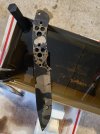I have used AAA for 80 CRV2 and hit 66+ out of the quench, 62 after tempering 2 hours at 350 in my kitchen oven. 80crv2 can have a lot of decarb, too. My kiln can take a LOOOONG time to rebound (120V and it's a top opening kiln with elements in the lid) and it often drops 100-200 degrees when I pull out a blade for quenching. I have done 4 or 5 blades at a time in the kiln when I do a batch. So I do my 10-15 min soak time at temp, then take a blade out, quench it, wait another 5 min or so to make sure the next blade is back up to temp and quench the next one. It also allows my oil to cool down a bit, too. So the last blade may be in there a while longer, but they are all fairly consistent HRC. I do use ATP41 now when doing carbon steels or spray graphite lube to try to prevent some decarb. I did 52100 and 80CRV2 into AAA at around 90-115 degrees (it was only like 35-40 degrees outside, so I had to put a few hot steel bars into the oil to heat it up from 35 degrees!!) The bars came out of the kiln, too, so I had to let the kiln rebound then, too. Once at temp, quenching the blades helped keep it warm and I often had to wait a bit for it to cool down again.
If doing stock removal, some guys had better results going through a full Normalizing, thermocycle, DET anneal, etc because the steel they had was very spheroidized and not in the best condition for hardening. Others reported steel from NJSB didn't need extra processing for stock removal, but I still often go through the whole process just so I know the steel will be the same all around. Sometimes if I have a one of blade that I forged, I may do that alone in the forge, but I try to normalize it, let cool, then do some thermocycles before quenching. I used Parks 50 this time (was doing a 1084/15N20 blade at the same time) and after tempering around 400, both were at 60-61 rockwell.

